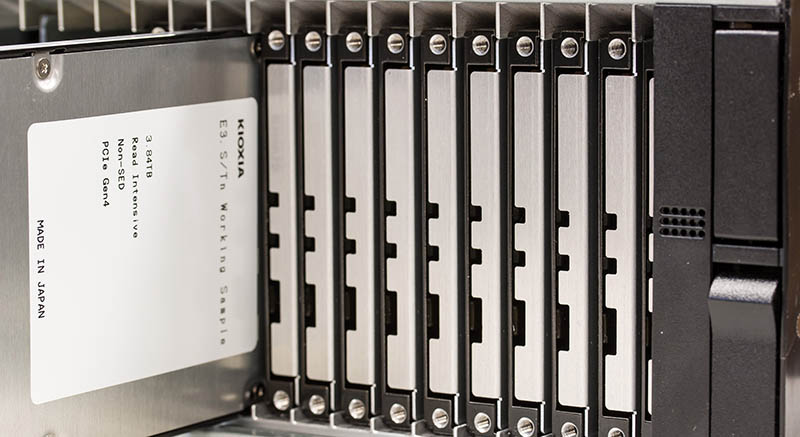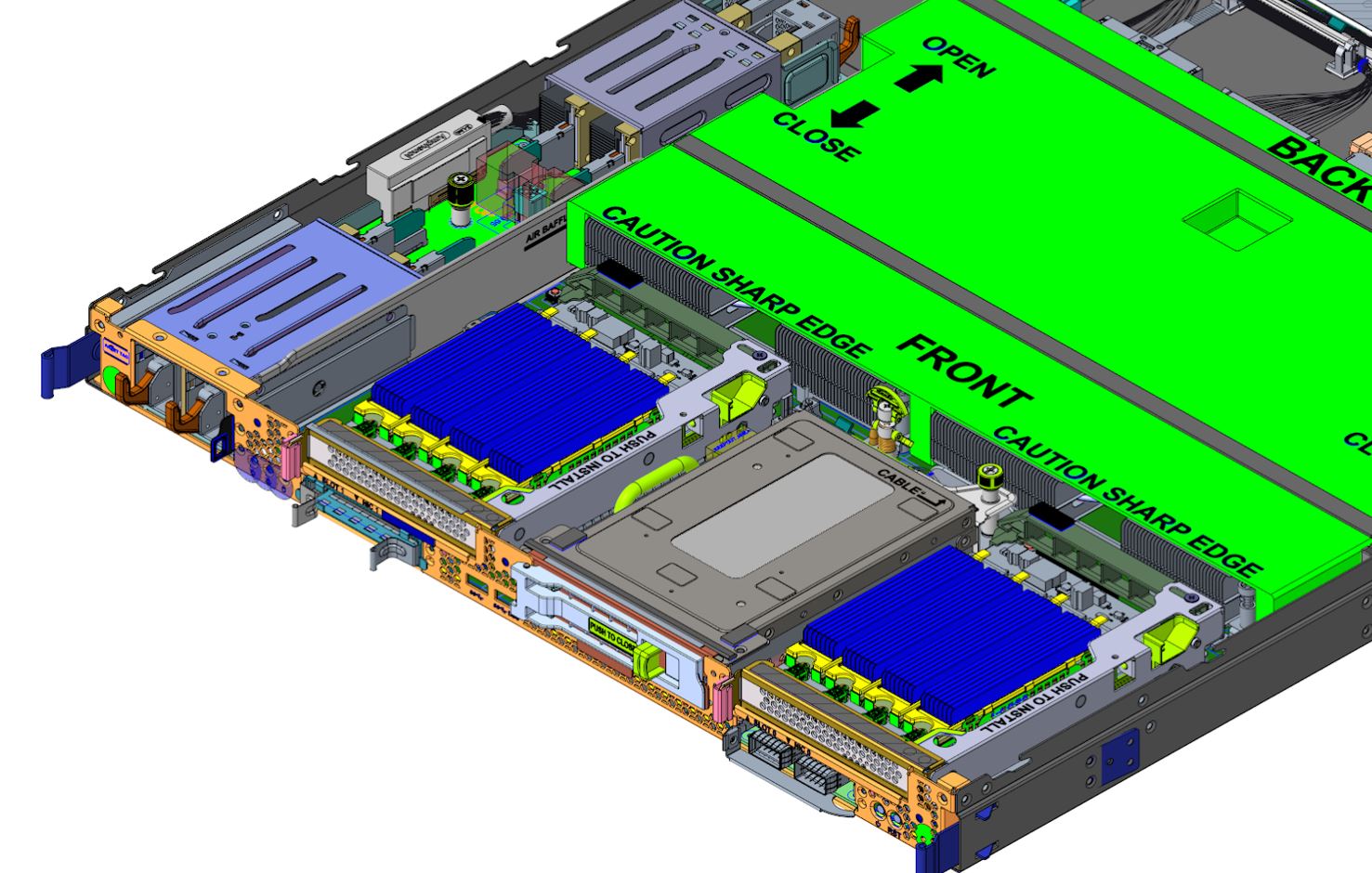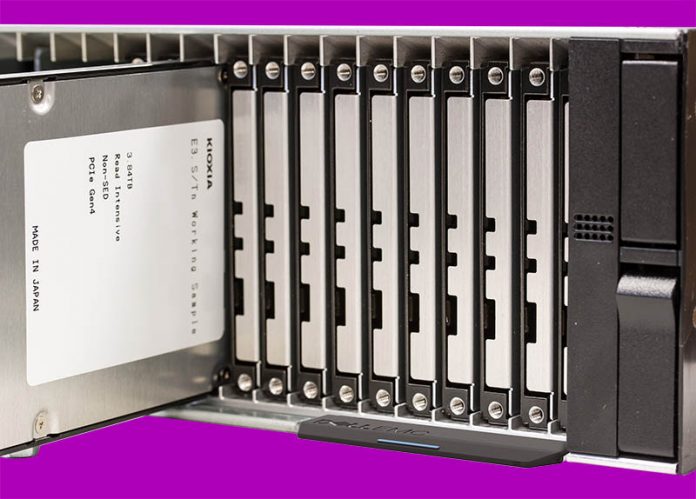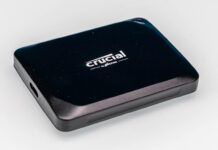EDSFF is going to be the form factor of the future and Kioxia is adding to the form factor’s momentum with a new product demonstration. For those that are not aware, EDSFF is a next-generation SSD form factor that is designed from the ground up to support SSDs instead of rotating hard drives. Kioxia is aiming to be an early adopter of the new form factor to start getting early customer wins before all of its competitors enter the market.
Why EDSFF?
Your typical 2.5” drive bay was designed for SATA and SAS rotating hard drives. The 2.5” form factor is a size that the industry thought could service both enterprise storage and the notebook segment.
These days, things have changed. We rarely see notebooks with 2.5” drives these days. 3.5″ drives are great for high-capacity scale up and out storage, but drive manufacturers are resorting to surreptitiously substituting DM-SMR technology to get margin out of declining segments. Buying SAS hard drives for performance enterprise storage means you are buying drives with lower performance, endurance, capacity, and reliability, with higher power consumption.
EDSFF is designed to be a PCIe standard for SSDs. Primarily, these are NVMe SSDs. The longer and thinner form factor better aligns with the fact that instead of spinning disks, we now have NAND chips on PCB. EDSFF allows for better placement of these NAND packages for optimal cooling. Since NVMe SSDs are PCIe based, and there is more room for power and cooling in a form factor that was not designed for a spinning disk, the ecosystem is looking at EDSFF to provide more than just storage even to accelerators and perhaps even memory in the CXL PCIe Gen5 era.
Kioxia EDSFF “Ruler” SSD Foray
The new Kioxia EDSFF SSDs come in the “E3” form factor. We will be seeing E3.Short (E3.S) and E3.Long (E3.L) variants in both thick and thin form factors in the near future. There are also capabilities to expand a traditional PCIe x4 connector. Today’s Kioxia drives are E3.S Thin (7.5mm) in size. E3.S thick is 16.8mm which is about the width of two drives plus the space between them. Kioxia’s EDSFF development vehicle is based largely around components in its Kioxia CM6 PCIe Gen4 SSD for traditional form factors.
Something that one can readily see in the photo Kioxia distributed is that this Dell box does not have the drive latches. I asked our Editor-in-Chief, Patrick, about this. He said latch design is a big deal and differentiator in the emerging ecosystem for EDSFF servers.

Kioxia is certainly looking to the future. This PCIe Gen4 development SSD uses 28W but Kioxia is looking to 40W and PCIe Gen5 in the future.
Final Words
After I sent this article in, I learned STH has an EDSFF server platform piece scheduled for next week. It is safe to say there is more EDSFF coverage coming from STH in the near future. For now, momentum is converging on this being a major part of the ecosystem going forward. Given that we saw designs for ruler SSDs in Facebook and Microsoft cloud servers years ago when we saw Where Cloud Servers Come From Visiting Wiwynn in Taipei, and the fact that Facebook is using EDSFF in its 3rd Generation Intel Xeon Scalable “Cooper Lake” platforms, it seems as though there is a strong market building for EDSFF which Kioxia is getting ready to enter.






The advantage of 2.5″ drives is that they fit interchangeably in the same bays. How do the four combinations of E3 short or long and thick or thin make the replacement for a single standard?
Eric Olson
These are systems that will be sold completely populated with drives – they are not going to be available for general purchase, and are already a standard. the 2.5″ drives will still have a place – but no way you can get close to 1PB in a 1U case with 2.5″ drives. Pre configured servers don’t need anything other than the 1 form factor they decide to use.
Not aware of any push for a single standard for storage.
Bob,
You can purchase systems from SuperMicro that do not have the storage bays fully populated.
But, Eric’s question/point is still valid… 4 variants is not what I would call a “standard”.
Reminds me of the old SCSI days, SCSI-narrow, SCSI-wide, SCSI-fast, SCSI-fast and wide, ULTRA SCSI, etc.
I agree that a lot of admins like the 2.5inch factor because it’s one standard, and you can swap your storage around. You don’t need to worry about if the other system is short or long, or what. I know the interface for SATA/SAS is an issue. I read somewhere about the same interface auto-detecting different modes. It would be so much easier if the industry went that way.
I’m guessing the sizes are going to work something like this:
* E3.Short fits into E3.Long with an adapter, like how a 2.5″ drive can fit into a 3.5″ bay with an adapter but a 3.5″ drive can’t fit into a 2.5″ bay.
* E3 thin is the base slot.
* E3 thick takes up 2 E3 thin slots, like how some addin cards are double wide.
* E3 thin fits into E3 thick slots with an adapter.
Looking at the development pic, the separators are very short, and they wouldn’t intrude on the space for all of the internals. Since an E3 thick is a double wide E3 thin, a shallow channel in the drive case should work to allow compatibility. A server with 10 E3 thin slots would allow for 5 E3 thick slots.
This doesn’t seem any worse then the current situation where we have 2.5″, 3.5″, U.2, and M.2 drives.
We’ve been looking at an SSD based storage server. It’s pretty tough trying to figure out which NVMe platform we should be considering going forward. Gigabyte and Tyan have interesting EPYC based options using established U.2 drives. Or should we wait a little and try and pick which EDSFF (E1.S, E1.L, NF1) formats will gain broad support. How long will U.2 hang a round.
It’s great to hear STH is going to be covering EDSFF in more detail over the next few weeks. Hopefully you can give us a clearer idea of where the SSD storage/server market is heading over the next few years.
Greg. There is an immense amount of change happening in late 2021/ early 2022. Systems then will start to look a lot different and my sense is that EDSFF will make more sense then unless you need the performance/ density now. All vendors do not have in-market EDSFF yet so there is still some time.
Thanks for your thoughts Patrick. EDSFF’s density would be nice but not essential right now. With the issues we’ve had with RAID rebuilds on our existing NAS device, we’d rather move to an SSD Array and ZFS sooner rather than latter.
Speaking of NAS issues, thanks for coverage of the WD SMR/CMR issue. FYI We are based in a small market (Switzerland) without a direct WD subsidiary and our reseller has been good regarding swapping SMR drives for CMR.
Hey, as long as it’s on eBay in 10 years, I’m all for it.
Kioxia == toshiba == DM-SMR drives (various models including one surveillance line)
Do you really want to reward bad behaviour by continuing to give that company your business?
So far in EDSFF we have E1 and E3, in long and short, thick and thin modes
Then we have M.3 (M2 enlarged, with hotswap)
And at least 2 more formats out there
These devices OK, but what happens in 3 years time when I need to replace a unit? which one will win? will there still be any of my chosen format available – and if there are, will they be reasonably priced, or stupidly expensive to cater to being a niche product that only sold a few thousand items?
Alan Brown
1. Do you need 500TB to 1PB in the near term in a 1U enclosure?
if no, then stick with 2.5″ form factor. EDSFF is a density play – and the PCIe4 drives from Intel (Optane) will be just as fast as the EDSFF drives coming from Intel (Optane) moving forward. 2.5″ isn’t going anywhere anytime soon.
And concerns about what will be available 3 years from now is a normal concern about tech and has been for some time – but I get your concern.